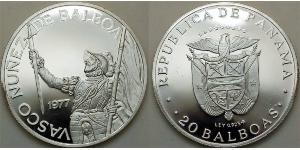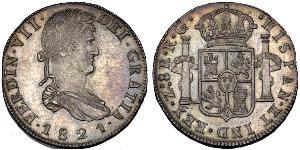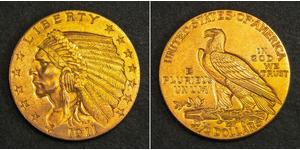8 Real (Vendida por $68.0)
1803, Mexico, Charles IV. Silver 8 Reales (Spanish Bust Dollar) Coin. Lustre AU+ This, currency was legal tender in the USA until 1857!
Mint Year: 1803 Denomination: 8 Reales Reference: 1803-MoFT, KM-109. Mint Mark: Mo (Mexico in Monogram). Assayer: Francisco Arante Cobos & Tomas Butron Miranda (FT) Condition: Minor scratches in obverse fields, small dark spots in reverse (material defects of the planchet, not a damage), otherwise a nice lustre AU+ Weight: 26.91gm Diameter: 40mm Material: Silver
Obverse: Laureate, draped, and cuirassed profile bust of Charles IV with roman armor right. Comment: The squares below the King´s cheek are impression of a die-classh, which represents the inverted shield of the reverse die! Latin Legend: CAROLUS . IIII . DEI . GRATIA . 1803 Translation: "Charles IIII by the Grace of God, 1803"
Reverse: Crowned Spanish* arms between the Pillars of Hercules adorned with PLVS VLTRA motto. Legend: .HISPAN[IARUM].ET IND[IARUM].REX.Mo[Mexico Monogram].8R [EALES] F.T.[Assayer Name] Translation: "King of the Spains and the Indies, Mexico [Mint], 8 reales".
*Details on the Spanish Arms: arms of Castile and Leon, with Granada in base and an inescutcheon of Anjou.
The Spanish dollar (also known as the piece of eight, the real de a ocho, or the eight real coin) is a silver coin, worth eight reales, that was minted in the Spanish Empire after a Spanish currency reform of 1497. It was legal tender in the United States until an Act of the United States Congress discontinued the practice in 1857. Through widespread use in Europe, the Americas and the Far East, it became the first world currency by the late 18th century. Many existing currencies, such as the Canadian dollar, United States dollar and the Chinese yuan, as well as currencies in Latin America and the Philippines peso were initially based on the Spanish dollar and other 8 reales coins.
Charles IV (November 11, 1748 - January 20, 1819) was King of Spain from December 14, 1788 until his abdication on March 19, 1808.
Charles was the second son of Charles III and his wife Maria Amalia of Saxony. He was born at Portici, while his father was king of the Two Sicilies. His elder brother Don Felipe was passed over for the two thrones as mentally retarded and epileptic.
Charles had inherited a great frame and immense physical strength from the Saxon line of his mother, granddaughter of August the Strong. When young he was fond of wrestling with the strongest countrymen he could find. While he was considered by many to be intellectually sluggish and quite credulous he was also known for his acts of kindness.
In 1788, Charles III died and Charles IV succeeded to the throne. Even though he had a profound belief in the sanctity of his office and kept up the appearance of an absolute, powerful monarch, he never took more than a passive part in the direction of his own government, occupying himself with hunting. The affairs of government he left to his wife and his prime minister. In 1792, Maria Louis finally succeeded in ousting the Count of Floridablanca from office and had him replaced with Pedro Pablo Abarca de Bolea, Count of Aranda, the chief of the Aragonese party. However, in the wake of the war against Republican France, the liberal-leaning Count of Aranda was replaced by Manuel de Godoy, a favourite of the Queen and allegedly her lover, who would henceforth enjoy the lasting favour of the King.
Godoy continued Aranda's policy of neutrality towards France but after Spain protested against the execution of the deposed king in 1793, France declared war on Spain and in 1795 forced Godoy to conclude an alliance and declared war on Great Britain.
In 1803, after smallpox had affected his daughter María Luísa, the king commissioned his doctor Francisco Javier de Balmis to bring the vaccine to the Spanish colonies on state expenses.
Spain remained an ally of France and supported the Continental Blockade until the the British naval victory at Trafalgar. However, After Napoleon's victory over Prussia in 1807, Godoy again steered Spain back onto the French side. This switching back and forth devalued Charles' position as a trustworthy ally while the return to the French alliance increased Godoy's unpopularity and strengthened partido fernandista, the supporters of Crown Prince Ferdinand, who favored a close relationship with Great Britain.
When King Charles was told that his son Ferdinand was appealing to Napoleon against Godoy, he took the side of the minister. When the populace rose at Aranjuez in 1808 he abdicated on March 19, in favour of his son, to save the minister who had been taken prisoner. Ferdinand took the throne as Ferdinand VII, but was distrusted by Napoleon who had 100,000 soldiers in Spain by that time.
Charles IV found refuge in France, and became a prisoner of Napoleon: the latter, posing as arbiter, summoned both Charles IV and his son to Bayonne in April and coaxed Charles (who had a difficult time restraining himself from assaulting his son) to retract his earlier abdication and abdicate, on May 5, 1808, in favour of Napoleon.
Charles was then interned in Talleyrand's castle in Valençay. He accepted a pension from the French Emperor and spent the rest of his life between his wife and Godoy, staying briefly in Compiègne and more durably in Marseille.
In 1812, he finally settled in Rome in the Palazzo Barberini, where he died on January 20, 1819.

|
Publicado por:
anonymous 2016-12-29 |
|
||
|
||
|
||
|
||
|
||
2.5 Dólar Estados Unidos de América (1776 - ) Oro
grupo tiene 259 monedas / 244 precios
⇑

-600-300-v70KX9ISfnEAAAFZ7yklg0kt.jpg)

-300-150-fP7BwcI0InEAAAEoDHP7lKXR.jpg)
 Deutsch
Deutsch Русский
Русский Українська
Українська English
English Italiano
Italiano Français
Français Español
Español 汉语
汉语





-300-150-FC3BwcI034cAAAEoFIp8PEi0.jpg)







